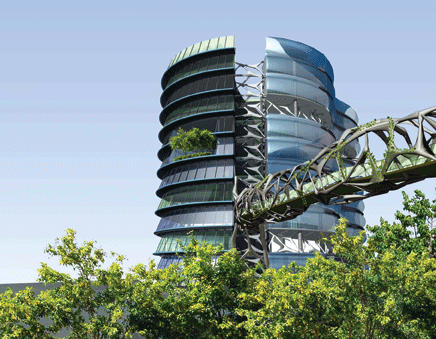
|
Published:
Local food for sustainable communities
Many people are waking up to the wisdom of growing food within and around cities and towns, a movement that is leading to the creation of more sustainable communities. Rachel Sullivan reports.
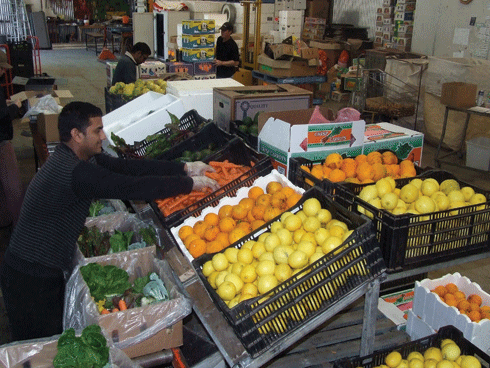
|
|
The packing line at Brisbane-based Food Connect, which is successfully matching local food producers to local buyers via a simple delivery program. Credit: Food Connect
|
Bringing food production much closer to home makes sense. As our population becomes more urbanised, the environmental and financial impacts of transporting produce to our suburbs have risen. Meanwhile, traditional agricultural belts are facing the challenges of water shortages, climate extremes and declining land productivity, while once-productive land on the urban fringe is being increasingly developed for housing and other infrastructure. This all coincides with concerns about the health and environmental impacts of large-scale commercial agriculture.
Until the Second World War, when advances were made in synthesising fertiliser, most people grew at least some of their own food. They kept a few hens, had fruit trees and large veggie patches. Scraps were fed to the chickens, or composted and mixed with animal manure then returned to the soil. Backyard food production was labour-intensive but highly productive,
and supplemented by produce from market gardens and smallholdings on
the urban fringe.
After the war, advances in machinery and synthetic fertilisers pushed production away from towns and cities into more marginal farmland. For the next 40 years, broadacre productivity in developed countries skyrocketed thanks to artificial pesticides and fertilisers and monoculture specialisation. Recently, however, growth slowed due to a combination of changing climate, existing crop varieties reaching their maximum yield potentials and progressive soil depletion. Waste products – water, manure and vegetable waste -– that were once composted and returned to the soil as an integral part of a closed production system, became a by-product liability.
Agriculture is also now responsible for 20 per cent of greenhouse gas emissions (GHGs) globally.1 Carbon dioxide is produced from making fertilisers and from running farm machinery, processing plants and delivery trucks. Methane is produced mostly by gut fermentation processes in cattle, and chemical processes taking place in farmed soils release nitrous oxide. Carbon is also indirectly released into the atmosphere from soil as a result of chemical applications, land clearing and conversion of savannah or pasture land to arable land, and from overgrazing and subsequent soil erosion.
Against this backdrop of concern about food’s environmental and health impacts, and more recently its future availability, people in urban areas have been rediscovering the pleasures of ‘slow food’, growing and picking their own produce, and purchasing freshly harvested fruit and vegetables from suburban farmers’ markets.
Making city space work
But can food forests, green roofs, backyard veggie patches and community gardens realistically feed the tens of millions predicted to live in the cities of the near future?
Yes, says Kirsten Larsen, an expert in sustainable food systems and Eco-Innovation Policy Research Manager at Melbourne University’s Victorian Eco-Innovation Laboratory (VEIL).
‘First we need to change our understanding of cities and start to see them as productive, not consumptive spaces.
‘While we’re not going to see fields of wheat or large-scale animal production in the heart of the city, there is a great opportunity for the production of fresh, perishable foodstuffs – especially fruit and vegetables – to expand, thanks to the concentration of water and nutrient resources in urban areas.
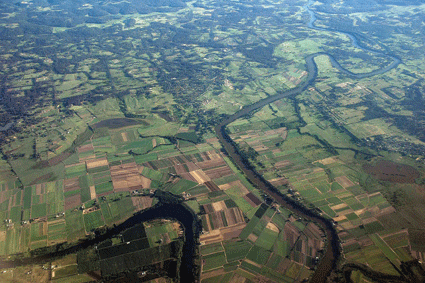
|
|
Looking down on Wilberforce, NSW, a typical growing satellite community with decisions to make about how to best use its productive surrounding land. Credit: Ian Sinclair
|
‘At the moment 47 per cent of waste going to landfill is organic; 21 per cent is food waste. Much of that could be composted or turned into mulch and returned to the soil to reduce reliance on fertilisers that are derived from fossil fuels.
‘Similarly, harvesting stormwater and wastewater from cities and making it available for crops after appropriate treatment will help close agricultural production loops.’
Larsen believes that ‘food-sensitive urban design’ can contribute to resilient, sustainable communities by diversifying food sources, making use of local resources, reducing transport and refrigeration needs, and spreading risk across different distribution channels. All of this contributes to positive community dynamics, not to mention greater food security. In Cuba, for instance, community gardens set up on disused land to compensate for reduced imports following the Soviet collapse now produce half the leafy vegetables consumed on the island.
To make urban agriculture viable again, Larsen says the same level of investment put into broadacre agriculture needs to be put into urban production systems.
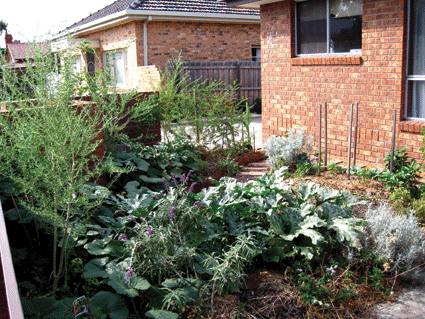
|
|
Kirsten Larsen’s home garden typifies the increasing popularity of GYO – Grow Your Own – produce. Credit: Kirsten Larsen
|
Further, we would need to look at utilising different spaces, such as basements and rooftop gardens. Larsen says Melbourne, for example, has a great deal of rooftop space that could be used for food production, if certain engineering challenges could be overcome.
Rooftop gardens are appearing in Japan and the USA, notably Chicago and New York. In New York’s Brooklyn district, an organic farm has been established on the 550-square-metre roof of a defunct bagel factory (see www.rooftopfarms.org). The gardeners behind the project say they are ‘committed to a sustainable business model that supplies fresh, locally grown organic food and spreads food education throughout New York’. Day-of-harvest deliveries are made by bicycle or locals can pick their own. It has been so successful that organisers are planning to expand into other vacant land.
New skill sets will be required to grow vegetables and fruit on walls and in aquaponics systems. Aquaponics, currently being trialled by Melbourne community farming group CERES Community Environment Park, is an ancient Aztec farming technique that combines fish-keeping and vegetable production. Similar to hydroponics, plants grow on rafts, with their roots dangling in water enriched by fish waste. The water is then filtered and recycled back into the fish tank.
Geoff Wilson, President of the Urban Agriculture Network-–Western Pacific, says the technique allows relatively small areas to be highly productive. ‘With fish food the only input, aquaponics has the potential to be one of the world’s major food production systems.’
Another new idea is vertical farming, a concept that originated with Professor Dickson Despommier from Columbia University’s Department of Health Sciences. Custom-built skyscrapers would bring large-scale food production into the place where most of the food is consumed. Food could be produced year round in a climate-controlled, parasite-free environment, seeing the end of harvests lost to droughts and storms. Features such as water and nutrient recycling, biogas-powered cogeneration, geothermal heating and cooling, and rooftop PV technology would minimise the environmental footprint of such skyscrapers.
Proponents also believe that using soilless growing media could be up to 30 times more productive than traditional broadacre cultivation.
In an article published in Scientific American, Despommier posited that vertical farms could help combat the effects of climate change, allowing transport-related GHGs to be cut dramatically and carbon sequestering forests to be planted on former farmland.
But while there has been considerable interest in vertical farms, with prototypes on the drawing board, at the moment they are prohibitively expensive: to be viable, each farm would need to feed around 50 000 people, be ~30 storeys high, and cost hundreds of millions of US dollars to build. This could make skyscraper-farmed crops more expensive than those grown by traditional methods.
Australian architect Oliver Foster believes that retrofitting existing structures may be a more cost-effective solution. Pricing energy and materials at their true ecological value in a carbon trading framework would also make alternatives, like high-rise farming, more economically viable.
Community learning benefits
Back on the ground, permaculture food forests such as Brisbane’s Northey Street City Farm (www.northeystreetcityfarm.org.au) not only provide an edible landscape with more than 1500 exotic and native fruit trees, bush tucker plants, shrubs and groundcovers growing on the 4 ha farm site, they also provide a focal point for the community, and an education in permaculture, horticulture and sustainable living.
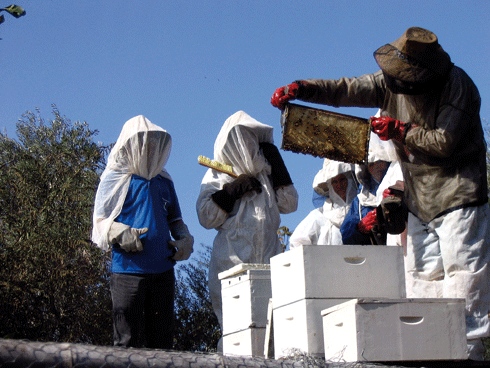
|
|
Members of Brisbane’s Northey Street City Farm harvesting honey. They produce great local food, share skills and connect to their wider community. Credit: Northey Street City Farm
|
Kirsten Larsen believes this educational component is critical to the success of urban farms. ‘There has been an increasing distance between production and consumption of food and many people now don’t have the skills to feed themselves,’ she says. Even in successful community gardens, which have often been set up as part of social welfare initiatives in multicultural or disadvantaged communities, education could help boost production significantly.
Through the Stephanie Alexander Kitchen Garden Program schoolchildren are learning about food production and healthy eating from an early age. Supported by federal government funding, the program involves 91 schools Australia-wide, with more being added each year. Children from Years 3–6 spend 45 min a week tending an organic vegetable garden they help create, then an additional hour-and-a-half learning to cook and prepare meals from the food they harvest.
While inner-urban food production is critical to future food security and advocated by The CSIRO Home Energy Saving Handbook as an important part of sustainable living, Ian Sinclair, Principal Consultant at Edge Land Planning, believes the urban fringes will continue to play a major role in a decentralised urban agriculture mix.
‘However, land use conflicts need to be managed at the regulatory level,’ he says. ‘At the moment, a lot of perishable food production occurs on the urban fringe in cities. Greater Sydney, for example, produces 15 per cent of the state’s total vegetables, but when looking at the perishable or fresh component, the Sydney region produces 90 per cent of Asian vegetables consumed in the state, and 80 per cent of its mushrooms.
‘But as the population has grown, development has steadily encroached onto rich productive farmland. High rates and complaints from neighbours, who like sweeping rural vistas but object to the sounds and smells of farming, are driving farmers off the land.’
Offsetting food supply shortage
Indeed, there is growing concern that the development-driven spread of urban infrastructure is permanently ‘paving over’ the highly valuable and most productive soils near cities – a natural asset that often attracted settlement in the first place. Beyond these areas, land is more marginal or degraded. Observers, including renowned conservationist David Suzuki2 and state government planners, say city planners need to do more forward-looking assessments to safeguard these areas.
|
The Slow Food movement (www.slowfood.com) began in Italy in 1989 in opposition to the fast food lifestyle sweeping the world. It currently has 100 000 members in 132 countries, many of whom are active in forming and sustaining seed banks that preserve ‘heirloom’ crop varieties; preserving and promoting local and traditional food products, and developing an ‘Ark of Taste’ for each ecoregion; educating citizens about the drawbacks of commercial agribusiness and factory farms; helping to preserve family farms; and encouraging ethical buying in local marketplaces. |
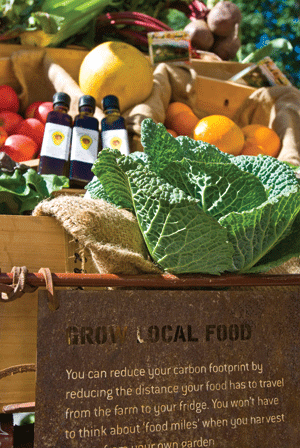
The Slow Food movement advocates a return to locally and sustainably grown and prepared produce. Credit: Food Connect
|
‘We need to plan for food, and identify where good land lies, where there are good soils and not too much fragmentation, then zone that land as primary production only, with a caveat placed on it,’ Ian Sinclair says.
He points out that if we want local food systems, farmers also need to be provided with an incentive to stay.
‘Rate rebates are one such incentive. Another could be market-based, where development credits are ascribed to farmland and could be redeemable for projects involving higher urban density to take the pressure off land.
‘In the future we will be able to feed ourselves from urban food production models, but we also need to make policy decisions and need to provide incentives to retain rural land now.’
Professor Julian Cribb, author of the forthcoming book The Coming Famine,3 says that year-round availability of food has contributed to a massive population explosion that, by 2050, will give rise to a dozen cities of 30 to 40 million inhabitants. Unless things change radically, his research reveals, none will produce enough food, leaving them almost entirely dependent on outside food sources.
‘When supplies fail, as they almost inevitably will for some reason, the ensuing catastrophe will appall humanity,’ says Cribb. Among the reasons for such supply failure, he cites the fact that most agriculture depends on fossil fuel for transport, processing equipment and other equipment; with thousands of new cars on the road each day in China and India, by 2050 there won’t be any fossil fuel available for food production, according to Cribb.
Phosphates and nitrates for fertilisers will also run out. Most of the nutrients taken from soils in the form of produce consumed by urban populations during the past 50 years have been flushed out to sea. Increasing water shortages will continue to affect production, and climatic extremes resulting in droughts, floods and bushfires will have catastrophic effects.
The consequences of an unreliable food supply would be dire, says Cribb, who argues that since the 1990s, two-thirds of all conflicts in the world have been caused by shortages of land, food or water.
‘Bringing food production back into the cities where it is consumed, and intelligently recycling nutrients back into agriculture or horticulture, is essential if we are to stave off disaster,’ concludes Cribb.
Connecting the dots
Brisbane-based Food Connect has created an innovative community-based food distribution model that brings together small producers – including people who grow excess veggies in their home gardens, community gardeners, school farmers and even ‘gleaners’ (people who collect fruit growing on street trees) – with 1600 subscribers who want to purchase seasonal, locally grown produce.

|
|
Geoff Buckley from Food Connect poses with staff and a fresh delivery of home-grown tamarillos. Credit: Food Connect
|
‘We source our produce from 80 growers who live within a couple of hours of Brisbane,’ says Robert Pekin, who goes by the charming title of CiEiO of Food Connect. ‘Farmers send their produce to a homestead on the outskirts of Brisbane. It is then packaged into 11 different types of boxes and dropped off at various locations around the city – family homes, schools and community centres – and subscribers collect their box from there, hopefully getting the chance to talk to like-minded others in the process.
‘The organic content of the boxes varies – sometimes it is as high as 100 per cent, but we opt for locally grown produce over organically certified,’ he adds. ‘That said, no chemicals are sprayed directly onto the fruit and vegetables before consumption and all of our farmers, some of whom also supply eggs and dairy products, meet strict ethical and animal husbandry standards.’
Pekin comments that this model has multiple benefits: it encourages farmers to grow a more diverse range of foods, which is good for the environment, and ensures they are fairly compensated for their produce. They don’t need to transport their produce as far, which saves time, energy and money, all of which they are able to put back into growing high quality crops.
The formula has proved so popular that Food Connect is about to launch in Sydney, Melbourne and Adelaide, with other cities and regional towns such as Bellingen and Coffs Harbour expected to follow suit.
More information:
Victorian Eco-Innovation Lab (VEIL),
http://www.ecoinnovationlab.com
Australian City Farms and
Community Gardens Network,
www.communitygarden.org.au
Stephanie Alexander Kitchen Garden Program, www.kitchengardenfoundation.org.au
1 http://www.climateandfarming.org/pdfs/FactSheets/IV.1GHGs.pdf
2 Read more at www.davidsuzuki.org/Economy/Sustainability/alr_report
3 The Coming Famine by Julian Cribb will be published in 2010.


